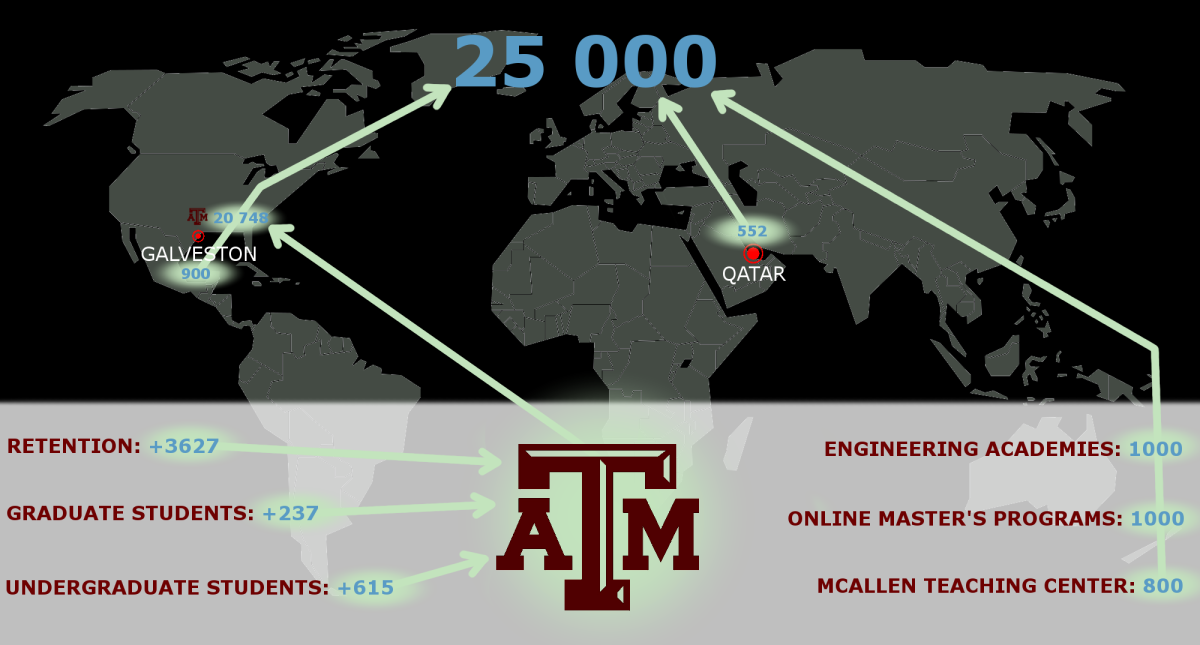The 25 by 25 objective, which aims to have 25,000 students enrolled in the College of Engineering by 2025 is, according to the College of Engineering, right on schedule.
The plan calls for approximately 6,831 new engineering students in the worldwide A&M system, and the College of Engineering has not wavered in their resolve to use increased retention rates as the primary source of these students, according to Katherine Banks, vice chancellor and dean of engineering.
“Our future growth will be primarily retention and online Master’s degrees, as well as remote locations,” Banks said. “We don’t expect any growth on this campus in terms of number of students.”
According to Banks, the foreign locations include Galveston, Qatar and various engineering academies in Texas like Blinn College in Bryan and El Centro College in Dallas.
As for the College Station campus, there will be, as Banks and others have previously mentioned, little to no influx of new students; the main focus will be on retention, as that rate is, according to Banks, far lower than the College of Engineering would like it to be.
In order to increase these rates, the College of Engineering will be expanding the living-learning community that is currently in Mosher Hall, according to Valerie Taylor, senior associate dean for Academic Affairs.
“Fall 2016, we had 650 beds available to students,” Taylor said. “For fall 2017, we have 3,100 beds available to students. In addition to the living-learning communities, we’ll also have, for example, peer mentors and the living-learning community supplemental instruction.”
According to Taylor, all four Commons dorms will have living-learning communities in them by fall 2017. However, Taylor said there would be more to these communities than just helping students with their homework.
“In addition to the academic programs, we’ll have themes for the students, and the themes resulted from input from the students,” Taylor said. “Some of the themes include engineering entrepreneurship, service-based learning, also health was another theme, so the living-learning community will be theme-based as well as academics.”
These themes, according to Taylor, would serve to help all freshmen and sophomores in those halls.
However, the College of Engineering is doing far more than simply increasing retention rates and promoting its remote campuses. According to Mark Weichold, professor of electrical and computer engineering, the 2017 Engineering Showcase was a tremendous success.
“We had close to 200 student teams that demonstrated their projects, ranging from freshmen through seniors,” Weichold said. “We had a very large number of judges from industry coming to quiz the students and judge the winners of the various prizes.”
Students who went to the Showcase not only got to display their innovative engineering projects to the world, but also got time to talk to people from prestigious companies about potential internships and jobs. According to Taylor, there is also a new program for all incoming engineering students that will begin in the fall of 2017.
“One program that’s starting in the fall, and it will be required for all of our incoming freshmen and thereafter, and that’s the Engineering X program,” Taylor said. “Students have what we call an X-factor, which is an extracurricular activity, it’s outside of the classroom, and it relates to a student’s passion.”
The idea is to have every engineering student present their engineering-related hobby or passion to the engineering department. Engineering X, according to Taylor, will be mandatory for all incoming freshmen starting in the fall of 2017, but those students will have four years to complete the project.
According to Banks, Taylor and Weichold, the 25 by 25 objective is still on schedule, and various new additions to the program, like Engineering X, are ensuring that the college of engineering sees drastic growth in the coming years.








